
Your Sinclair, or YS as it was commonly abbreviated, was a commercially published and printed British computer magazine for the Sinclair range of computers, mainly the ZX Spectrum. It was in circulation between 1984 and 1993.

Podophyllum is a genus of flowering plant in the family Berberidaceae, native from Afghanistan to China, and from southeast Canada to the central and eastern United States. The genus was first described by Carl Linnaeus in 1753.

Hakea is a genus of about 150 species of plants in the Family Proteaceae, endemic to Australia. They are shrubs or small trees with leaves that are sometimes flat, otherwise circular in cross section in which case they are sometimes divided. The flowers are usually arranged in groups in leaf axils and resemble those of other genera, especially Grevillea. Hakeas have woody fruit which distinguishes them from grevilleas which have non-woody fruit which release the seeds as they mature. Hakeas are found in every state of Australia with the highest species diversity being found in the south west of Western Australia.
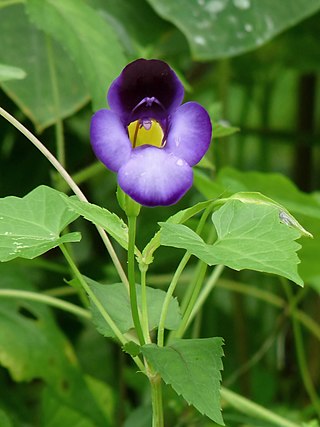
Torenia is a genus of plants now classified in the family Linderniaceae. Torenia has also been classified in the figwort family Scrophulariaceae. Often called wishbone flowers, bluewings; in Hawaii nanioola'a or ola'a beauty, some species are grown as garden plants. Many F1 and F2 Torenia hybrids have been hybridized in the last 30 years. Colors can range from white with yellow throats to violet, blue, cobalt, lavender and purple.

Linderniaceae is a family of flowering plants in the order Lamiales, which consists of about 25 genera and 265 species occurring worldwide. Vandellia micrantha is eaten in Laos, but tastes bitter. Best known are the wishbone flowers Torenia fournieri and Torenia thouarsii, which are used as bedding plants, especially in the tropics. Micranthemum is sold as an aquarium plant when it is called 'baby tears'.

Saurauia is a genus of plants in the family Actinidiaceae. It comprises about over 300 species distributed in the tropics and subtropics of Asia and South and Central America. Genetic evidence and the cell biology of the group support monophyly of the genus. Monophyly of the genus is also supported by micromorphological characters and by phylogenetic analysis, although the exact evolutionary relationships of Saurauia with the other two genera of the Actinidiaceae, Actinidia and Clematoclethra, are not well understood. It is also the only extant genus within its family whose natural distribution includes areas outside of Asia.
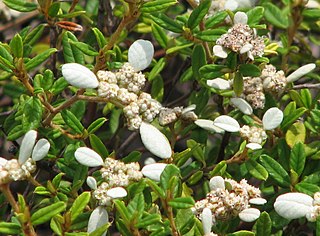
Spyridium is a genus of about thirty species of flowering plants in the family Rhamnaceae, and is endemic to Australia. Plants in the genus Spyridium are shrubs or subshrubs usually with small leaves, flowers usually in clusters of small composite heads, the individual flowers small and densely woolly-hairy, and the fruit a capsule. Species of Spyridium are found in all Australian states except Queensland.

Stackhousia is a genus of annual and perennial plants in the family Celastraceae that are native to Australia, New Zealand, Malesia and Micronesia. The genus was first described by James Edward Smith in Transactions of the Linnean Society of London in 1798.

Euphrasia collina is a perennial herb or subshrub in the genus Euphrasia. Plants grow to between 5 and 60 cm high and have leaves with 1 to 6 teeth per side. The flowers may be white, blue, pink or purple, sometimes blotched with yellow on the lower petal.
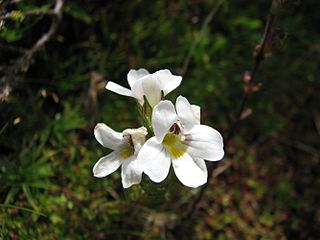
Euphrasia gibbsiae is a perennial herbaceous plant in the genus Euphrasia. It is native to Victoria and Tasmania in Australia. Species in this genus may be called eyebright.
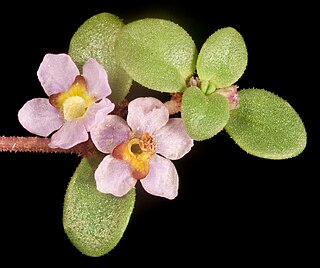
Glossostigma is a genus of flowering plants in the lopseed family, Phrymaceae.
William (Bill) Robert Barker is an Honorary Research Associate of the State Herbarium of South Australia.
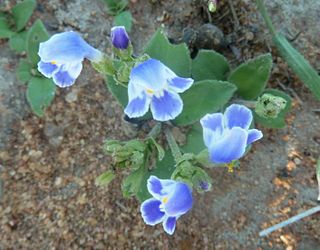
Craterostigma is a genus of shrub-like flowering plants in the family Linderniaceae, found in Africa, Madagascar, Socotra, the Arabian Peninsula, the Indian Subcontinent, Sri Lanka, China, Southeast Asia and Java. The best studied species is the resurrection plant Craterostigma plantagineum, known for its unique drought tolerance.
Uvedalia is a genus of flowering plants in the family Phrymaceae, native to Australia. It was resurrected from Mimulus in 2012.
Archboldiodendron calosericeum is a species of flowering plant belonging to the family Pentaphylacaceae. Its native range is New Guinea. It is the sole species in genus Archboldiodendron.
Bonnaya is a genus of flowering plants belonging to the family Linderniaceae.

Elacholoma is a genus of flowering plants belonging to the family Phrymaceae.

Peplidium is a genus of flowering plants belonging to the family Phrymaceae. Its native range is Egypt to Sinai, Indian subcontinent, and Australia.

Peplidium foecundum is a plant in the Phrymaceae family, native to South Australia, Queensland, the Northern Territory and New South Wales.














